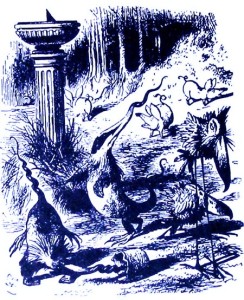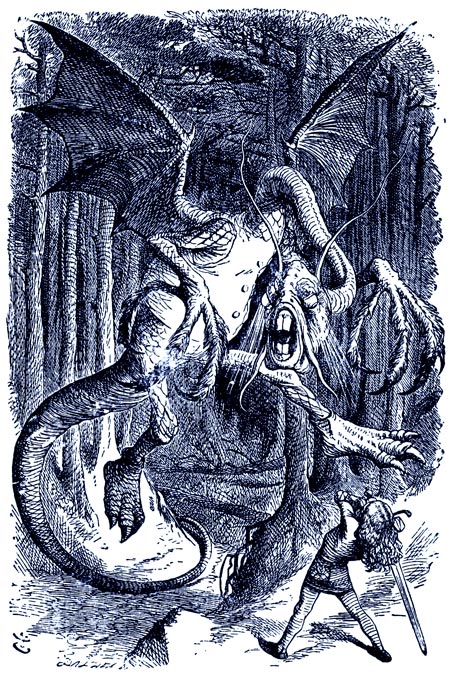The Jabberwock character is a scary monster in Lewis Carroll’s poem called “Jabberwocky”
This poem tells the story of a brave man who sets out to slay the Jabberwock, and finally returns home with his head.
`Twas brillig, and the slithy toves
Did gyre and gimble in the wabe;
All mimsy were the borogoves,
And the mome raths outgrabe.`Beware the Jabberwock, my son!
The jaws that bite, the claws that catch!
Beware the Jujub bird, and shun
The frumious Bandersnatch!’He took his vorpal sword in hand:
Long time the manxome foe he sought —
So rested he by the Tumtum gree,
And stood awhile in thought.And as in uffish thought he stood,
The Jabberwock, with eyes of flame,
Came whiffling through the tulgey wook,
And burbled as it came!One, two! One, two! And through and through
The vorpal blade went snicker-snack!
He left it dead, and with its head
He went galumphing back.`And has thou slain the Jabberwock?
Come to my arms, my beamish boy!
O frabjous day! Calloh! Callay!
He chortled in his joy.`Twas brillig, and the slithy toves
Did gyre and gimble in the wabe;
All mimsy were the borogoves,
And the mome raths outgrabe.
Jabberwocky – Nonsence Poem
The “Jabberwocky poem” was written by Lewis Carroll and featured in his novel ‘Through the Looking-Glass and What Alice Found There’ (1872). Even though it is said that Carroll wrote the poem as a parody designed to show how not to write a poem, it is considered by many to be one of the greatest nonsense poems written in the English language.

Several of the words in the poem are nonsense words from Carroll’s own imagination. In the book, the character of Humpty Dumpty gives definitions for the nonsense words in the first stanza. In later writings, Lewis Carroll explained several of the others. The rest of the nonsense words were never explicitly defined by Carroll, who claimed that he did not know what some of them meant.
An extended analysis of the poem is given in the book ‘The Annotated Alice’ by Martin Gardner (1960). It includes writings from Carroll about how he formed some of his idiosyncratic words. A few words that Carroll invented in this poem, like “chortled” and “galumphing”, are still being used in the English language. The word ‘jabberwocky’ itself is sometimes used to refer to nonsense language in general.
Bendicct Cumberbatch reading the much loved poem Jabberwocky
Lewis Carroll’s inspiration for the Jabberwocky Poem
The poem was written during Lewis Carroll’s stay with relatives at Whitburn, near Sunderland, although the first stanza was written in Croft on Tees, close to nearby Darlington, where Carroll lived as a boy. The story may have been inspired by the local Sunderland area legend of the Lambton Worm, as noted in “A Town Like Alice’s” by Michael Bute (1997 Heritage Publications, Sunderland) and as later adapted in “Alice in Sunderland” by Brian Talbot.
The first stanza of the poem originally appeared in Mischmasch, a periodical that Carroll wrote and illustrated for the amusement of his family. It was entitled “Stanza of Anglo-Saxon Poetry.” Carroll also gave translations of some of the words which are different from Humpty Dumpty’s. For example, a “rath” is described as a species of land turtle that lived on swallows and oysters. Also, “brillig” is spelled with two ys rather than with two is.
Roger Lancelyn Green, in the Times Literary Supplement (March 1, 1957), and later in The Lewis Carroll Handbook (1962), suggests that the rest of the poem may have been inspired by an old German ballad, “The Shepherd of the Giant Mountains”. In this epic poem, “a young shepherd slays a monstrous Griffin”. It was translated into English by Lewis Carroll’s relative Menella Bute Smedley in 1846, many years before the appearance of the Alice books.
The inspiration for the Jabberwock allegedly came from a tree in the gardens of Christ Church, Oxford, where Carroll was a mathematician under his right name of Charles Lutwidge Dodgson. The tree in question is large and ancient with many sprawling, twisted branches somewhat suggestive of tentacles.
Jabberwocky has been translated into several languages
“Jabberwocky” has become famous around the world, with translations into many languages. The task of translation has been difficult because many words of the poem are nonce words simply made up by Carroll, having had no previous meaning. Some words are derived from blending two words and their meanings into a new word meaning something else.
Although the poem contains many nonsensical words, its structure is perfectly consistent with classic English poetry. The sentence structure is accurate and the poetic forms are observed, e.g. quatrain verse, rhymed, iambic meter.
In Through the Looking-Glass Alice enters the reflected version of her own house through a mirror and she finds a book with looking-glass poetry, “Jabberwocky”. Alice realises that she can only read the reversed printing by holding it up to a mirror. Alice finds the poem scary but curious: “Somehow it seems to fill my head with ideas – only I don’t exactly know what they are!” [Source: Wikipedia]
Humpty Dumpty’s translation of words in Jabberwocky
- Brillig: – to broil / 4 o’clock in the afternoon, the time when you start broiling things for dinner
- Slithy: -blended from slimy and lithe / slimy and active
- Tove: -like a badger or a lizard or a corkscrew. They nest under sun-dials and live on cheese.
- Gyre: -to go round and round like a gyroscope
- Gimble: -to make holes like a gimblet
- Wabe: -a grass-plot round a sun-dial, because it goes a long way before it, and a long way behind it.
- Mimsy: -blended from flimsy and miserable
- Borogove: -a shabby looking bird with its feathers sticking out all round, looks like a live mop.
- Rath: -a sort of green pig
- Mome: -short for “from home”, meaning that they’d lost their way.
- Outgrabe: -past tense of Outgribe / something between to bellow and to whistle, with a kind of sneeze in the middle
SEE ALSO > 101 Famous Quotes From Alice In Wonderland Interactive eBook
[Jabberwocky video by Laughing Cynic]
 `Twas brillig, and the slithy toves
`Twas brillig, and the slithy toves